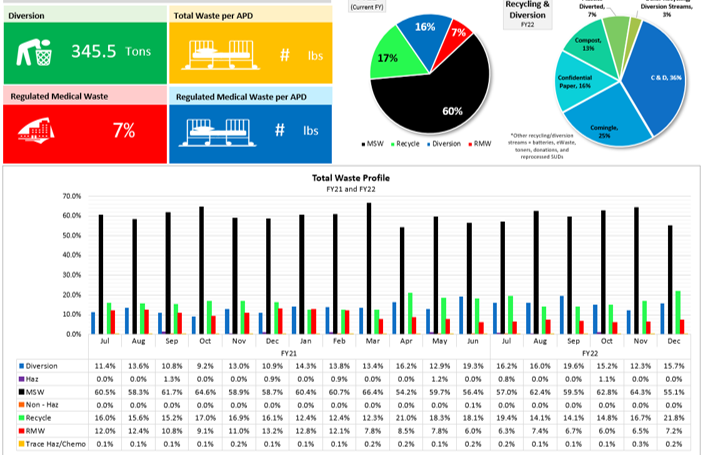How to Reduce Waste and Costs at your Business
According to the United Nations, over 2.12 billion tons of waste is disposed of annually. Guess what? Industrial and commercial businesses contribute to the vast majority of all the waste dumped worldwide every year. Reduction In Motion can help you with how to reduce waste; we are a waste reduction company who has helped organizations make sustainability possible for 20 years.
Sadly, waste places a serious burden not only on our environment but also on our economy. If you run a business that produces significant waste, reducing the amount of waste you generate will save money and improve your environmental impact.

Unlike what most people think, reducing waste at your company goes beyond saving money on costly waste hauling. It also demonstrates niche leadership and serves as corporate social responsibility for your company.
Come to think of it… Could any corporate social responsibility be better than reducing greenhouse gas emissions and the global hazards to human health due to our waste stream? Of course none, after all, health is wealth.
We can’t do away with wastes completely in most operating environments because it’s cultural. However, you can develop a strategic waste management plan to reduce waste and the cost that comes with it.
But before we proceed, let’s quickly go through the benefits of reducing the waste your company generates.
Waste Reduction Benefits
Your company stands to gain a lot if you have a creative strategy in place to reduce waste. Here are some of the benefits of waste reduction.
#1. Conserve Space
One of the benefits of waste reduction is that it helps you to conserve space within your company and its immediate environment. One way you can do this by adopting a compost program.
Interestingly, whenever you conserve space in the existing landfills and cleanfills, you are indirectly conserving natural resources.
#2. Reduce Pollution and Energy Consumption
If you have a strategy that focuses on reducing waste, it will reduce pollution and energy consumption. Pollution from waste is causing more global warming, especially when they aren’t disposed of correctly.

So, when you try to reduce waste from your company’s activities, you aren’t only helping your business but also humanity generally. You can read our guide to a green office for a better understanding of how to make your operating environment pollution free.
#3. It Reduces Impact on Your Host Community
If you operate in the construction industry, your company’s waste doesn’t affect your immediate environment alone. It also impacts your host company. But investing in waste reduction reduces the impact of noise, traffic, and dust on the surrounding buildings and streets.
#4. Save Money on Supplies
Every waste reduction strategy focuses more on the efficient use of supplies. This will help to reduce the cost of purchasing new supplies as well as the waste disposal cost.
#5. It Enhances Your Company’s Image
The art of reducing waste helps to enhance your company’s image and gives your brand a niche leadership status. Clients will always be happy to repeat business with you when they see how prudence you are with your resources.
#6. Reduce Risks from Hazardous Materials
If you have a waste reduction strategy in place, there will be less risk associated with hazardous materials. This is because every process within your operation will be closely monitored to minimize waste.
Again, there will be strict adherence to recommended practices when dismantling hazardous material. This will help to ensure the safety of your employees and reduce waste.
You can get a free trash consultation on how to reduce risk from hazardous materials through waste reduction.
#7. Reduce the Possibility of Future Liability
Disposing of waste is expensive. And if you fail to manage it correctly, it could form a larger chunk of your overhead expenses. An easier way to reduce or possibly avoid this cost is to have a waste reduction strategy in place.
You see, your company could benefit more from adopting a waste reduction strategy than you can imagine. And it’s an easy way to give good publicity to your brand without spending much.
If you wonder how you could reduce waste and costs on your company’s campus, here are some strategies to try.
Waste Reduction Strategies
From experience, the easiest way to lower your facility’s cost and its environmental impact is through your waste stream. Here are 5 Strategies to reduce waste and costs on your company’s campus;
#1. Have a Centralized Purchasing and a Reuse Store for Office Supplies
The easiest way to reduce waste in your company is to have a centralized purchasing store for your office supplies. Without a doubt, a large chunk of most companies’ waste comes from office supplies.
However, establishing a centralized purchasing store for office supplies will give you control over their usage to an extent.
With a central purchasing system, you can limit the purchase of supplies like scissors, pens, and pencils, sticky notes, facial tissues, tape, file folders, etc. This will help to reduce redundant purchases and reduce overall purchasing costs.
Furthermore, place the items mentioned above in a central location where staff can easily access them. And make it a rule that all staff must put the supplies they aren’t using in the central area. This makes it easier to reuse some of these items and reduces the number of used or expired items disposed of.
Again, make it part of the staff’s request process to seek out supplies in the central store before submitting a purchasing request for new items.
If every member of your team is committed to this process, you will spend less on new purchases and reduce the waste your company produces or generates.
Several companies that adopted a centralized purchasing and reuse store actually got great results in cost and waste reduction.
For instance, when Fairview Health Services (a Minnesota-based healthcare system) established reuse stores in two hospitals and two office buildings, they made every staff member take from the reuse store before ordering for new supplies.
Interestingly, after two years of implementation, Fairview health services saved over 1 million dollars in office supply costs, $300,000 in furniture costs, and more importantly, they reduced their waste by 30,000 pounds.
You see, your company could achieve more if you implement the strategy.
#2. Offer Reusables in Break Rooms or Cafeterias
The use of disposable tableware is a common source of waste in most organizations. So, as part of your strategy to reduce waste, don’t purchase or provide disposable tableware. Instead, encourage your staff to always come with their reusable mugs, plates, flatware, etc.

If possible, you can provide reusable wares and wash them on-site. Again, if you already have disposable takeout containers in your break room or cafeteria, you can replace them with returnable and reusable ones. For instance, the use of stainless steel utensils reduces greenhouse gas by about 77 percent.
Furthermore, if there is no dishwasher in your company’s break room, try to install one. It makes the transition to reusable tableware easier for your employees.
#3. Improve Your Recycling Program
If you can improve your facilities’ waste and recycling process, it would go a long way to reduce waste. But it takes commitment and consistency on your part to achieve this.
Start by creating waste stations with different bins for trash, recyclables, and food. Ensure that the stations are located conveniently with clear signage and labels for each of the containers. This directs people how to properly separate their waste into each bin.
Once you have fully implemented waste stations, let your employees know that waste reduction is part of the company’s policy, and recycling is an essential step towards achieving it. This will make every staff member conscious about how they dispose of waste, and they will become more prudent with resources.
#4. Manage Your Food Waste
Your effort to reduce waste won’t be achievable if you aren’t giving attention to food waste (compostables). A significant percentage of our overall waste stream is comprised of compostable materials. And according to the United States Environmental Protection Agency, feeding people and animals is one of the easiest ways to manage food waste.
If you work with food-related products in your company, try to establish an organics recycling program within your facility.
If you are using paper towels for hand drying in your bathroom, you should install an organic recycling bin where your staff can separate organic waste (be sure your composting program can accept paper towels first, though).
Similarly, install organic recycling containers in your kitchen or cafeteria. Ensure that your kitchen staff undergoes training on how to properly dispose of food prep-waste in the organic recycling bin.
There should also be provision for post-consumer food waste in your organic recycling program. So, educate your staff on how to separate food waste for disposal in the dining area into the right organic recycling bin. Check our article of Food waste management to get a better idea on how to manage food waste within your company.
#5. Conduct Waste Assessment on Your Company’s Environment
Ideally, before executing any waste reduction strategy, it’s advisable to conduct a comprehensive waste assessment of your facility. The assessment will enable you to understand the best way to reduce waste and save your facility costs.
A waste assessment has to do with a detailed evaluation of the wastes your company currently generates and how they are managed. At the end of the assessment, you will have an idea of the following:
- The type of trash your company generates and how it is being disposed of
- Items in the trash that you can reduce, reuse, or recycle
- The size of the trash bins and the frequency at which they are collected.
While it’s an excellent idea to reduce your company’s waste, it requires constant communication and collaboration with your employees. You may not get immediate results, but there will be great cost savings within the first two years.

Our team of sustainability and waste consultants work together to develop content for our site. Contact us to learn more about something we’ve written about or would like us to focus on in the future.


